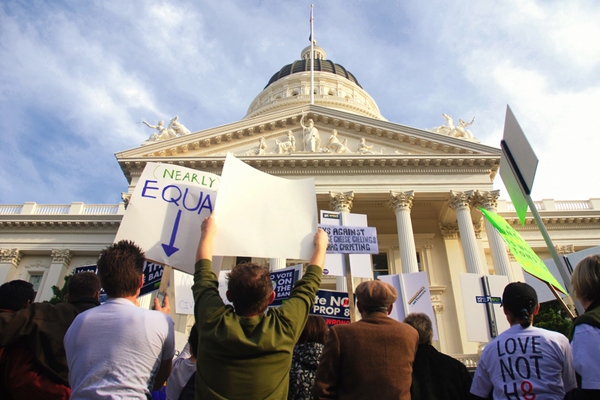3Qs: How the gay marriage movement has evolved


On Tuesday, the U.S. Supreme Court began hearing oral arguments on the constitutionality of the Defense of Marriage Act and California’s gay marriage ban enacted by Proposition 8. We asked Sarah Jackson—an assistant professor of in the College of Arts, Media and Design whose research focuses on how social and political identities are constructed in the public sphere—to explain why public support for gay marriage has increased in recent years and how the social movement compares to others in the country’s history.
Recent national opinion polls have indicated that support for same-sex marriage is increasing. What factors have contributed to the shift?
Increased visibility of LGBTQ Americans, especially since the 1990s, has played an important role in shaping public opinion. The LGBTQ movement did have significant moments of public visibility before this—including the Stonewall Riots in the 1960s, the election of Harvey Milk in the 1970s, and the work of ActUp in the 1980s.
But the 1990s brought an unprecedented rise of pop culture representation. When Ellen DeGeneres came out on her TV show in 1997, it was a very risky move and many advertisers pulled their support. However, her risk showed media-makers that Americans were willing to identify and empathize with gay characters. Soon after, Will and Grace arrived on the scene, and we’ve since seen a huge increase in LGBTQ characters both on network and cable channels.
These pop culture representations have allowed us to see LGBTQ Americans living lives much like other Americans, thus dispelling past stereotypes that suggested LGBTQ people didn’t embrace American values. Advertisers have now also recognized the economic value of the LGBTQ market and begun to target the very group they were previously afraid to acknowledge. Visibility in pop culture has also served to highlight the visibility of LGBTQ Americans, and the challenges they face, in other parts of the public sphere like politics and education.
What strategies have gay rights activists most successfully employed to advance their cause? What have they learned from previous social movements in America?
Efforts for social change are one of the primary characteristics of human history, so many movements have and continue to influence one another. One strategy that the LGBTQ movement has used successfully that can be linked both to the civil rights and feminist movements is that of mainstreaming their agenda. Rather than focus on more controversial issues that challenge taken-for-granted norms in American society, mainstream legs of the civil rights and women’s movements simply asked to be included in already accepted structures and norms. Civil rights organizations demanded the same access to schools and buses as their white counterparts, while feminists argued that they should have the same opportunities of employment and pay as their male counterparts.
Similarly, the LGBTQ movement has focused on the idea that LGBTQ people deserve the same access to rights like marriage as their straight counterparts. It’s important to keep in mind that often such mainstream demands didn’t, and don’t, reflect all the challenges that African-Americans, women, and LGBTQ people face, but they are a place to start.
Likewise, the LGBTQ community has formed organizations like GLAAD (which focuses on fair and inclusive media representations), and the Human Rights Campaign (which focuses on raising awareness and lobbying for legislative change). Organizations such as the NAACP (in the case of the civil rights movement) and NOW (which rose out of the feminist movement) did and continue to do similar work for their constituencies. Uniquely, and because of evolving technologies, organizations that focus on LGBTQ issues have been able to communicate their messages more quickly and to larger audiences than the pre-21st-century organizations they are modeled after.
Do you see momentum from the same-sex marriage fight as a force strong enough to advance other social causes across the United States?
Most social movements never end; they simply evolve with the historical and political moment. Unfortunately, popular opinion sometimes implies that if one battle is won the fight is over. The civil rights movement faced this challenge with the passage of Brown v. Board of Education and other landmark cases, which, while hugely significant, did not dissolve racial inequality as a problem in America.
Similarly, if DOMA and Prop 8 are overturned by the Supreme Court, that won’t solve all the issues faced by LGBTQ Americans. However, a potential victory could help to strengthen the movement’s infrastructure in ways that would allow it to tackle other issues that disproportionately impact its community, such as poverty, hate crimes, and teen homelessness.
Victory, however, is not necessary for the movement to survive. Every social movement in documented history faced many defeats in the process of pushing for social change; it was long-term resiliency and commitment that allowed these movements to accomplish eventual wins.





